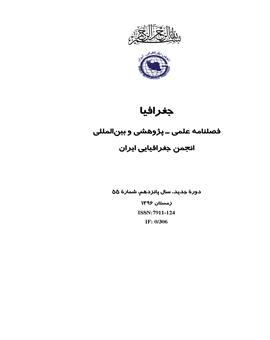تحليل پويايي فقر شهري در كلان شهر تهران 1375 - 90
محورهای موضوعی :
1 - عضوهیات علمی دانشگاه خوارزمی
2 - خوارزمي
کلید واژه: فقر, فقر شهري, پويايي, كلان شهر تهران,
چکیده مقاله :
امروزه ضعف مطالعات فقرسنجي و رويكردهاي فرد مبنا در بررسي فقر در شهرها تقريباً بر همگان آشكار شده است. مي توان گفت شناخت و تحليل واقع بينانه فقر در مناطق شهري نيازمند افزودن بُعد مكاني و زماني مسئله است. زماني كه صحبت از فقر به ميان مي آيد، بُعد فضايي يا مكاني آن بايد درنظر گرفته شود. اين مقاله با روش توصيفي و تحليلي و با تكيه بر داده هاي بلوك آماري كلان شهر تهران در سه دوره سرشماري 1375-1385 و 1390 به بررسي تغيير و تحولات فقر و پويايي آن پرداخته تا بتواند الگوي فضايي تحرك فقر در اين كلان شهر را ارائه نمايد. نتايج تحقيق كه با استفاده از آماره موران محلي و خودهمبستگي فضايي به دست آمده، نشان مي دهد كه فقر در كلان شهر تهران طي ادوار موردمطالعه به سمت خوشه اي شدن حركت كرده و از حالت متفرق به وضعيت به هم پيوسته و خوشه اي تغيير شكل داده است كه مقدار آماره موران 31/0 براي سال 1375، 41/0 براي سال 1385 و 78/0 براي سال1390 مي باشد، نيز مويد همين امر است.
Today, the weakness of poverty Measuring and individual-based approaches to poverty survey in cities have been revealed to almost everyone. It can be said that the realization and analysis of poverty in urban areas requires adding spatial and temporal dimension of the problem When it comes to poverty, spatial or locational dimension should be considered. This paper It has been done with use of descriptive and analytical method and based on the statistical block data of Tehran metropolis in the three censuses of 1375-1385 and 1390 to Display the changes and evolution in poverty and its dynamics ,to present the spatial pattern of poverty mobility in this metropolis. The results of the study, which have been obtained using local moron statistics and spatial autocorrelation, show that poverty in Tehran metropolitan area has been moving towards clustering over the course of the study period and from a dispersed condition to a converging and clustered condition, That, the amount of Moran statistics is 0.31 for 1375, 0.41 for 1385 and 0.78 for 1390 It also confirms this matter.
1. ادل، ماتیو (1380)؛ اقتصاد سیاسی شهری و منطقهای، ترجمه فریبرز رئیس دانا، نشر قطره، تهران چاپ اول؛
2. باباپور، میترا (1391)؛ تحرک درآمدی و پویایی فقر و نابرابری در ایران: رویکرد دادههای شبه¬پنل، پایان¬نامه کارشناسی ارشد دانشگاه الزهرا؛
3. رمضان پور، ندا (1393)؛ پویایی فقر در ایران، تجزیه فقر به فقر گذرا و مزمن، با استفاده از الگوی شبه ترکیبی، پایان¬نامه کارشناسی ارشد اقتصاد، دانشگاه الزهرا تهران؛
4. غمامی، مجید، خاتم، اطهاری کمال (1386)؛ مدیریت یکپارچه و حل مسئله اسکان غیررسمی، مجموعه شهری تهران، انتشارات مرکز مطالعات و تحقیقات شهرسازی و معماری ایران؛
5. مارکس، کارل (1384)؛ فقر فلسفه، ترجمه م رازی، نسخه الکترونیکی؛
6. محسنی، الهام (1387)؛ سیمای فقر در شهر تهران، پایان¬نامه کارشناسی ارشد اقتصاد، دانشگاه الزهرا تهران؛
7. مهدوی وفا، حبیبالله، رضویان، محمدتقی، مؤمنی، مصطفی (1388) نقش اقتصاد سیاسی در ساختار فضایی تهران و پیرامون، مجله محیطشناسی شماره 50، صص 1-50؛
8. هاروی، دیوید (1394)؛ عدالت¬اجتماعی و شهر، ترجمه محمدرضا حائری، انتشارات سازمان فناوری ارتباطات و اطلاعات شهرداری تهران؛
9. Addison, Tony, David Hulme, Ravi Kanbur (2007), Poverty Dynamics: easurement and Understanding from an Interdisciplinary Perspective;
10. Azhar Hussain, Mohammad, (2000), Poverty Dynamics in Denmark, Germany and the USA, The Danish National Institute of Social Research;
11. Beccaria Luis, Laura Fernandez, Roxana Maurizio, Paula Monsalvo, Mariana Alvarez(2011), Urban poverty and labor market dynamics in five Latin American countries: 2003–2008, Partnership for Economic Policy (PEP);
12. C. Reyes, A. Tabuga, C. Mina, R. Asis and M.B. Datu (2011), Dynamics of Poverty in the Philippines: Distinguishing the Chronic from the Transient Poor Philippine Institute for Development Studies;
13. Creedy, john,guyonne Kalb(2006), Dynamics of inequality and poverty, University of Melbourne, Victoria, Australia;
14. Dahl Espen Tone Fløtten Thomas Lorentzen(2005), Poverty dynamics and social exclusion –An analysis of Norwegian panel data Paper to be presented at the Annual Conference of the International Sociological Association’s Research Committee on Poverty, Social Welfare and Social Policy (RC19), Chicago, 8-10 September 2005;
15. Desmond, matthew (2012), Eviction and the Reproduction of Urban Poverty, American Journal of Sociology (AJS) Volume 118 Number 1;
16. Hojman, Daniel,Felipe Kast(2009), On the Measurement of Poverty Dynamics, Faculty Research Working Papers Series, John F. Kennedy School of Government, Harvard University;
17. Islam, nezamul,Abebe Shimeles(2007), Poverty dynamics in Ethiupia State Dependence and transitoty Shocks;
18. Krishna, anirudh, (2016), the dynamics of poverty, The Oxford Handbook of the Social Science of Poverty;
19. Pinoncely, Victoria(2016), Poverty, place and inequality, Why place-based approaches are key to tackling poverty and inequality, Royal Town Planning Institute;
20. Polin,Veronica, Michele Raitano(2012), Poverty Dynamics in Clusters of European Union Countries: Related Events and Main Determinants, Working Paper Series Department of Economics University of Verona;
21. Proudhon,p, j(1996), the philosophy of misery;
22. Ren, Chunhui (2011), Modeling Poverty Dynamics in Moderate-Poverty Neighborhoods: A Multi- Level Approach Graduate Program in City and Regional Planning The Ohio State University.


